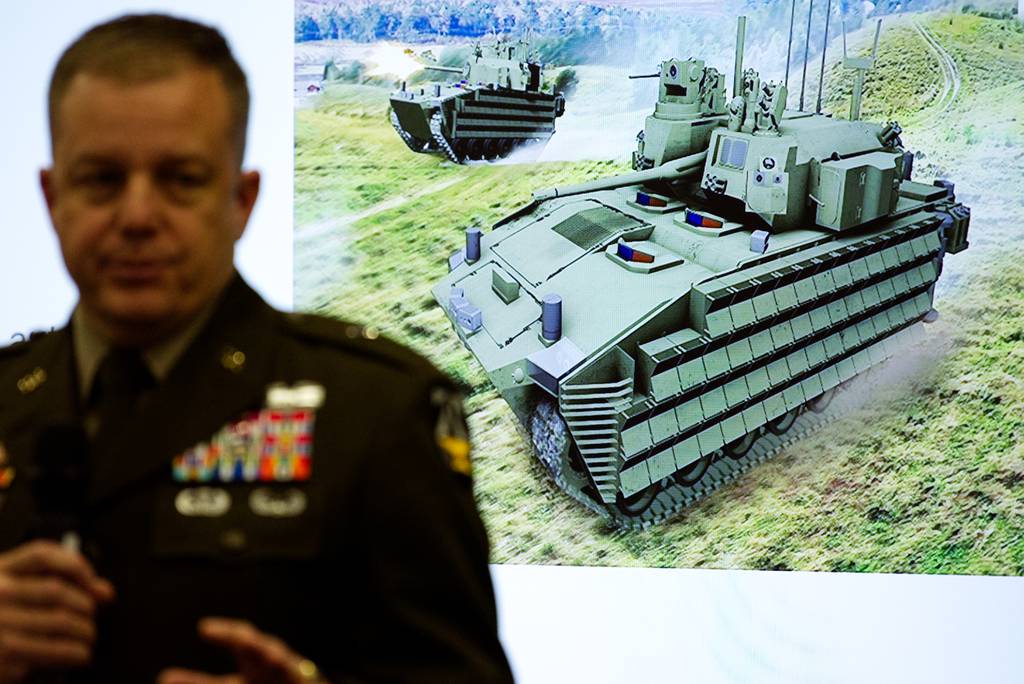
The Army is embarking on a strategy to implement a digital engineering environment meant to speed the pace, lower the cost and reduce risk in weapons systems development, according to Jennifer Swanson, the service’s deputy assistant secretary for data, engineering and software within its acquisition branch.
Gabe Camarillo, the Army under secretary, who previewed the effort last fall, signed the directive in May, Swanson said, which enables the Army to grow its digital engineering capability across the force using current development programs to pave the way while promoting increased interoperability and developing a capable and experienced workforce.
Already, the defense industry is using digital engineering, including digital twins, to develop future vertical lift aircraft, combat vehicles and even hypersonic weapons.
“We view digital engineering as the linchpin of all the digital transformation efforts that we have ongoing today,” Swanson said in a June 18 press briefing at the Pentagon.
“Data, the way that software communicates, the output of that software, and how we inform our soldiers and commanders to make real time decisions, [artificial intelligence] [are] pivotal, critical,” she said. “Leveraging that data, leveraging those software capabilities; digital engineering is really how it all comes together,”
The directive policy has four tenets. The first is to establish digital engineering focus areas, the second is to promote interoperability and implementation across the force, the third is to establish and monitor programs identified as “pathfinders” and the fourth is to develop talent and expertise.
The Army has identified three focus areas for the strategy: Ground vehicles; aviation; and sensors.
The aviation focus area takes many lessons learned from industry which has been using digital engineering for aircraft design heavily. The Future Long-Range Assault Aircraft, one of the DE pathfinder programs, was designed from the beginning in a digital environment and has served as a prime example for how the service plans to develop major weapon systems digitally going forward. FLRAA was built and flown in record time because it was designed digitally.
The ground vehicle focus area will draw from the automotive industry, according to the directive, which, “leverages DE heavily in designing cars and trucks today and has gained tremendous efficiencies and increased quality as a result.”
The Army is already using digital engineering in its XM30 Mechanized Infantry Combat Vehicle competitive design effort from the very beginning and is therefore one of the service’s pathfinder programs to “illustrate DE’s potential contributions, highlight existing policies and processes that may hinder a program’s ability to implement DE and identify how to advance DE adoption in various contexts,” the directive states.
XM30 program challenges
The challenges programs face as they begin to implement digital engineering as part of the design and development process were recently highlighted in the XM30 program. In the Government Accountability Office’s weapon systems annual assessment, officials found “it took longer to release the request for proposals due to a lack of experience with digital engineering while directing contractors to use specific software design approaches.”
Additionally, the Army “lacked precedent for scoping a digital open architecture project, which delayed the Source Selection and Evaluation Board process,” the GAO found.
XM30 was “really first in terms of putting [DE] out in an RFP that way,” Swanson said. “There was learning to be done and so I think that’s why it took a little bit longer, but I think sometimes you do have to go a little slow to go fast because I think they will absolutely benefit and the return on investment is there.”
One of the challenges that still exists, and that the XM30 program is working through, is related “to the fact that we don’t have interoperable digital engineering tools in industry,” Swanson said. “It’s a big problem.”
The Army “is not going to direct everybody to use a certain tool,” she said. “The lack of ability to cleanly and easily share data between all those tools causes challenges and that’s not just inherent to what we’re doing. That’s across the industry.”
The industry is planning to adopt new standards for digital engineering tools to increase interoperability to solve that challenge, Swanson said. The goal to establish those standards is targeted for the end of the summer, she added.
Other pathfinder programs the Army is using to guide its digital engineering transformation are the Integrated Fires Mission Command, the Joint Targeting Integrated Command and Control Suite, the M113 Armored Personnel Carrier and the Program Executive Office Aviation Logistics Data Analysis Lab for UH-60 Black Hawk, CH-47 Chinook and AH-64 Apache helicopters.
Selecting some older programs as pathfinders, like the M113, may come as a surprise, but according to Swanson, the M113 has a digital twin
“There is a lot of reuse of parts between the M113 and our newer vehicles and so being able to take that digital twin, leverage it and evolve, it is great,” she said.
One of the bigger challenges as the Army seeks to execute the directive will be to extend digital engineering capabilities beyond the development realm.
“We want to build those digital threads from requirements all the way to sustainment,” Swanson said. “That requires all of our partners within the Army that help us acquire these technologies and these programs and so that’s really what this directive is about is being able to set the stage to enable everybody else to do it.”
Jen Judson is an award-winning journalist covering land warfare for Defense News. She has also worked for Politico and Inside Defense. She holds a Master of Science degree in journalism from Boston University and a Bachelor of Arts degree from Kenyon College.
- SEO Powered Content & PR Distribution. Get Amplified Today.
- PlatoData.Network Vertical Generative Ai. Empower Yourself. Access Here.
- PlatoAiStream. Web3 Intelligence. Knowledge Amplified. Access Here.
- PlatoESG. Carbon, CleanTech, Energy, Environment, Solar, Waste Management. Access Here.
- PlatoHealth. Biotech and Clinical Trials Intelligence. Access Here.
- Source: https://www.defensenews.com/land/2024/06/19/us-army-moves-out-on-digital-engineering-strategy/



